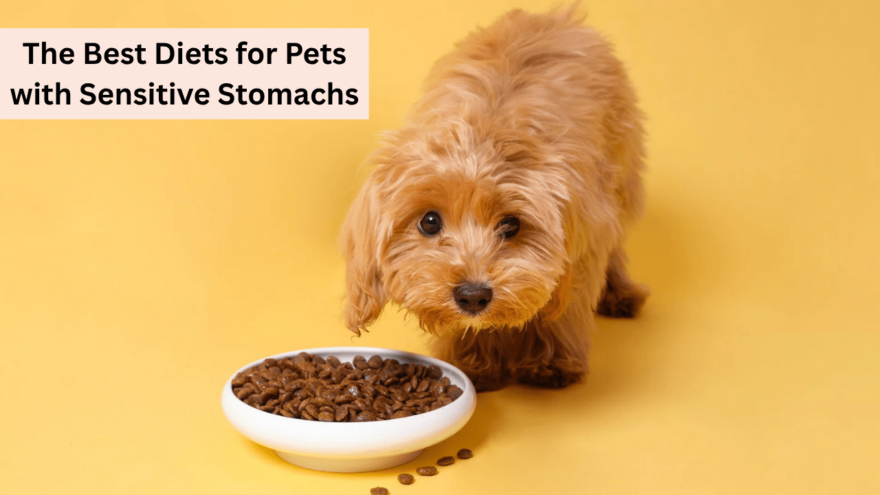Pets with sensitive stomachs can be a challenge for any pet owner. Vomiting, diarrhea, or excessive gas can signal that your dog or cat is struggling to digest their food. Finding the right diet is crucial to keeping them healthy and comfortable. This beginner-friendly article explores the best diets for pets with sensitive stomachs, offering simple, practical advice to help you choose the right food for your furry friend. We’ll cover common causes, dietary options, and tips to ensure your pet thrives, all in an easy-to-understand way.
Understanding Sensitive Stomachs in Pets
A sensitive stomach in pets refers to a digestive system that reacts poorly to certain foods or stressors, leading to symptoms like vomiting, loose stools, or bloating. Both dogs and cats can develop sensitive stomachs, and the causes vary widely:
- Food Intolerances or Allergies: Pets may react to ingredients like grains, dairy, or specific proteins (e.g., chicken or beef).
- Dietary Changes: Switching foods too quickly can upset digestion.
- Low-Quality Ingredients: Fillers or artificial additives in some commercial foods can irritate the stomach.
- Stress or Anxiety: Changes in routine or environment can affect digestion.
- Medical Conditions: Issues like inflammatory bowel disease (IBD) or pancreatitis may mimic a sensitive stomach and require veterinary attention.
If your pet shows persistent digestive issues, consult a veterinarian to rule out serious conditions. Once you confirm a sensitive stomach, adjusting their diet can make a big difference.
Key Features of Diets for Sensitive Stomachs
The best diets for pets with sensitive stomachs are easy to digest, made with high-quality ingredients, and tailored to your pet’s needs. Look for these features when choosing a food:
- Simple Ingredients: Foods with fewer ingredients reduce the chance of triggering sensitivities.
- High-Quality Proteins: Lean, novel, or hydrolyzed proteins are gentler on the stomach.
- Low Fat Content: High-fat diets can be hard to digest, especially for pets with conditions like pancreatitis.
- Easily Digestible Carbohydrates: Ingredients like rice or sweet potatoes provide energy without irritation.
- Probiotics and Prebiotics: These support healthy gut bacteria, aiding digestion.
- No Artificial Additives: Avoid foods with artificial colors, flavors, or preservatives, which can worsen symptoms.
With these features, you can narrow down options to find a diet that soothes your pet’s stomach.
Top Diet Types for Pets with Sensitive Stomachs
Several dietary approaches work well for pets with sensitive stomachs. Here are the most effective options, explained simply:
1. Limited Ingredient Diets (LID)
Limited ingredient diets contain fewer components, making it easier to identify and avoid triggers. These foods typically use a single protein source (e.g., duck or salmon) and one carbohydrate (e.g., sweet potato). LID foods are ideal for pets with food allergies or intolerances. Many brands, including well health organic pet food, offer LID options formulated for sensitive stomachs, ensuring high-quality ingredients without unnecessary fillers. Always check labels to confirm the food avoids your pet’s known triggers.
2. Hydrolyzed Protein Diets
Hydrolyzed protein diets break proteins into tiny pieces that are less likely to cause allergic reactions. These prescription foods, available through veterinarians, are often used for pets with severe food allergies or chronic digestive issues. They’re highly digestible and effective but can be expensive. Your vet may recommend them if LID diets don’t work.
3. Novel Protein Diets
Novel protein diets use uncommon proteins like venison, rabbit, or kangaroo that your pet hasn’t eaten before. Since they’re new to your pet’s system, they’re less likely to cause reactions. These diets are great for pets with allergies to common proteins like chicken or beef. Pair novel proteins with digestible carbs like rice for a gentle meal.
4. Low-Fat Diets
Pets with sensitive stomachs, especially those with pancreatitis, benefit from low-fat diets. Excess fat can strain the digestive system, leading to discomfort. Look for foods with lean proteins and moderate fiber to support digestion without overwhelming the stomach. Your vet can suggest appropriate fat levels based on your pet’s condition.
5. Homemade Diets
Homemade diets allow you to control every ingredient, which is helpful for pets with specific sensitivities. A simple recipe might include boiled chicken, white rice, and steamed carrots. However, homemade diets must be nutritionally balanced to avoid deficiencies. Work with a veterinary nutritionist to create a recipe tailored to your pet’s needs, as improper balance can harm their health over time.
6. High-Fiber Diets
For some pets, high-fiber diets help regulate digestion and firm up stools. Fiber sources like pumpkin or psyllium husk can soothe the gut. However, too much fiber can worsen symptoms in some pets, so consult your vet before increasing fiber intake.
How to Choose the Right Diet
With so many options, picking the best diet can feel overwhelming. Follow these steps to make the process easier:
1. Consult Your Veterinarian
Your vet is the best resource for diagnosing the cause of your pet’s sensitive stomach. They may recommend blood tests, fecal exams, or food trials to pinpoint triggers. Based on their findings, they can suggest commercial or prescription diets suited to your pet’s needs.
2. Read Ingredient Labels
Check the ingredient list on pet food packages. Avoid foods with vague terms like “meat by-products” or artificial additives. Choose brands with clear, high-quality ingredients and certifications from the Association of American Feed Control Officials (AAFCO) for nutritional adequacy.
3. Consider Your Pet’s Preferences
A diet won’t work if your pet refuses to eat it. Introduce new foods gradually and monitor their reaction. If they enjoy the taste and show improved digestion, you’ve likely found a good fit.
4. Trial and Observe
Food trials are key to finding the right diet. Feed the new food exclusively for 8-12 weeks, as recommended by your vet, to assess its effectiveness. Keep a journal of symptoms like vomiting or stool quality to track progress.
Transitioning to a New Diet
Switching foods too quickly can worsen a sensitive stomach. Follow this gradual transition plan over 7-10 days:
- Days 1-2: Mix 25% new food with 75% old food.
- Days 3-4: Mix 50% new food with 50% old food.
- Days 5-6: Mix 75% new food with 25% old food.
- Day 7: Feed 100% new food.
Monitor your pet for signs of discomfort during the transition. If symptoms worsen, slow the process or consult your vet.
Additional Tips for Managing Sensitive Stomachs
Beyond diet, these tips can support your pet’s digestive health:
- Feed Smaller, Frequent Meals: Splitting daily portions into 3-4 small meals reduces strain on the stomach.
- Ensure Fresh Water: Hydration aids digestion, so keep clean water available at all times.
- Reduce Stress: Create a calm feeding environment and maintain a consistent routine.
- Add Probiotics: Vet-approved probiotic supplements can promote healthy gut bacteria.
- Avoid Table Scraps: Human foods, especially fatty or spicy ones, can trigger digestive upset.
Regular vet checkups are essential to monitor your pet’s progress and adjust their diet as needed.
Conclusion
Finding the best diet for a pet with a sensitive stomach takes patience and care, but the right food can transform their quality of life. Limited ingredient, hydrolyzed, or novel protein diets are excellent starting points, while homemade or low-fat options may suit specific needs. Always work with your veterinarian to ensure the diet is safe and balanced. By choosing high-quality ingredients, transitioning slowly, and monitoring your pet’s health, you can help them enjoy meals without discomfort. Your furry friend deserves a happy, healthy tummy!






